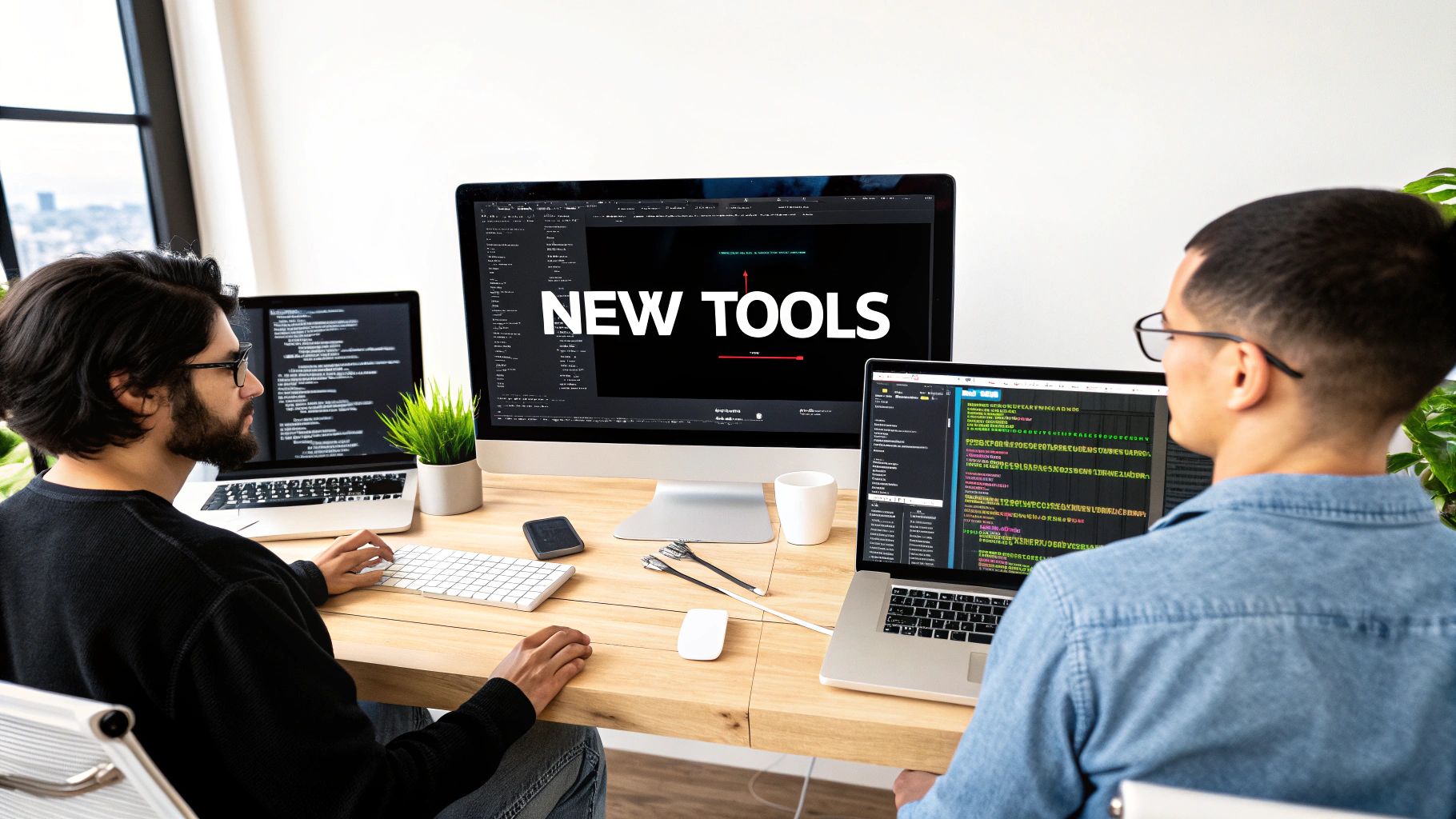Boost Efficiency: Improve Code Review Process Now
The Hidden Power of Effective Code Reviews

Effective code reviews are more than a simple quality check; they're a vital tool for improving software development as a whole. They help reduce defects, improve overall code quality, and speed up the development lifecycle. This happens because code reviews create a shared understanding of the codebase and encourage continuous learning within the team. Imagine a team developing a complex new feature. Through the code review process, potential problems are identified early, preventing costly rework down the line.
Why Focus on Improving the Code Review Process?
Creating a strong code review process is crucial for delivering reliable software. A 2022 survey found that 84% of companies have a formal code review process in place, and 36% consider it the most effective way to improve code quality. Aetna, for instance, saw an over 80% reduction in errors after implementing thorough code inspections.
The power of code reviews to catch bugs is clear. Data shows that inspections can uncover 55-60% of errors, a much higher rate than other testing methods. This makes optimizing the code review process essential for both product quality and team efficiency. When companies integrate code reviews effectively, they see significant improvements in both areas. For more detailed statistics, check out the TrustRadius 2022 Code Review Survey.
The Measurable Impact of Strategic Reviews
Strategic code reviews directly affect important performance metrics. They lead to a significant decrease in defect rates, which results in more stable and dependable software. Effective reviews also boost development velocity by catching issues early. This reduces the time spent on debugging and fixing issues later, meaning teams can deliver features more quickly and with better quality.
To illustrate the effectiveness of various quality assurance methods, let's examine the following comparison:
Code Review Effectiveness Compared to Other QA Methods
| Quality Assurance Method | Average Defect Detection Rate | Implementation Complexity | Team Adoption Rate | |---|---|---|---| | Code Review | 55-60% | Medium | High | | Unit Testing | 30-35% | Low | High | | Integration Testing | 20-25% | Medium | Medium | | System Testing | 10-15% | High | Medium |
This table demonstrates how code reviews, while requiring a moderate implementation effort, boast a considerably higher defect detection rate than other common QA methods. This highlights the value and effectiveness of code reviews in ensuring software quality.
Real-World Examples and Strategies
Many organizations have significantly improved their output quality by adopting systematic code review strategies. These strategies often involve creating custom checklists specific to their technology stack. They also establish graduated review intensities based on the level of risk and integrate reviews seamlessly into their existing workflows. For a comprehensive guide on best practices, see Best Code Review Practices.
Convincing Stakeholders of Review Value
Sometimes, demonstrating the value of code reviews to stakeholders requires presenting clear data. Showing the connection between effective code reviews and fewer defects, along with the positive impact on development speed, can be very persuasive. The article How to master code review best practices with data-driven strategies offers valuable insights. This data-driven approach helps stakeholders understand the return on investment (ROI) of dedicating time and resources to improving the code review process. Highlighting how better reviews contribute to a more positive and collaborative engineering culture can also be a strong argument.
Crafting Your Code Review Framework That Actually Works
Moving beyond informal feedback, a well-defined code review framework can significantly improve a team's output. This isn't just about finding errors; it's about creating a system that encourages collaboration, knowledge sharing, and continuous improvement. Let's explore proven approaches used by successful engineering organizations to scale their review processes effectively.
Building a Custom Review Checklist
A generic checklist isn't enough for most teams. To improve the code review process, consider your specific technology stack, coding style guides, and potential project risks. You might be interested in: How to master the perfect code review checklist. This means identifying common issues or vulnerabilities specific to your environment.
For example, a team working with a microservices architecture might prioritize checks for inter-service communication and data consistency. A team focused on security might emphasize vulnerability scanning and input validation.
Establishing Graduated Review Intensities
Not all code changes need the same level of scrutiny. A simple typo fix requires less attention than a major architectural change. By categorizing changes based on risk assessment (low, medium, high), you can allocate review resources more effectively.
This means low-risk changes might only need a quick review by one team member. High-risk changes require a more thorough review involving multiple senior developers. This approach optimizes the review process without creating bottlenecks for smaller, less impactful modifications.
Seamless Workflow Integration
Integrating code reviews into your existing workflow should be seamless. This often involves connecting the review process with your version control system like Git and project management tools like Jira. Automating parts of the process, like assigning reviewers or triggering automated checks, minimizes manual intervention and keeps the development flow moving.
Key Components of a Successful Framework
Several core components contribute to a robust code review framework. Let's outline them for clarity:
To understand the essential elements of a comprehensive code review process, refer to the table below. It provides implementation guidance and highlights common pitfalls to avoid.
| Framework Component | Purpose | Implementation Guidelines | Common Pitfalls | |---|---|---|---| | Clear Acceptance Criteria | Define what constitutes a successful review. | Establish specific, measurable, achievable, relevant, and time-bound (SMART) criteria. | Vague or subjective criteria lead to confusion and inconsistent reviews. | | Reviewer Selection | Ensure the right people review the right code. | Match reviewers with relevant expertise and code ownership. Utilize AI tools to assist in appropriate reviewer selection. | Assigning reviewers randomly or based solely on seniority can lead to ineffective reviews. | | Living Documentation | Maintain a central repository of review guidelines and best practices. | Create a wiki or internal documentation that evolves with your codebase and incorporates feedback from the team. | Outdated or inaccessible documentation can lead to inconsistencies and misunderstandings. | | Feedback Mechanisms | Facilitate constructive communication between reviewers and authors. | Encourage clear, respectful, and actionable feedback. Provide templates for effective comment phrasing. | Unclear or overly critical feedback can damage team morale and hinder collaboration. |
The table above summarizes the key elements needed for a successful code review framework. By addressing each component, teams can ensure consistent and effective reviews.

By incorporating these elements, teams can create a code review framework that improves code quality and fosters a culture of continuous learning. This collaborative approach ensures that reviews are seen as a valuable opportunity for growth.
Balancing Speed and Quality in Your Review Process

Modern development teams are constantly juggling the need for thorough code reviews with the pressure to release software quickly. This section explores how leading organizations manage to achieve both speed and quality in their code review process. We'll look at practical techniques for right-sizing reviews, implementing risk-based approaches, and using automation strategically.
Right-Sizing Your Reviews
When it comes to code reviews, a one-size-fits-all approach simply doesn't work. The depth and intensity of a review should align with the complexity and risk of the code changes. A minor typo fix, for example, doesn't require the same scrutiny as a major change to the core architecture.
Consider the context of the change as well. Is it a hotfix for a critical production issue? Or a new feature in early development? The urgency and potential impact will influence the best review approach. This allows teams to focus their review efforts where they matter most.
Implementing Risk-Based Review Tiers
Categorizing code changes based on risk is an effective technique for optimizing the review process. A risk-based tiering system (low, medium, high) helps determine the appropriate level of review rigor. Low-risk changes might only need a quick review by one team member. High-risk changes, however, would require a more comprehensive review involving multiple senior engineers.
This targeted approach ensures critical changes receive the attention they deserve without slowing down less impactful modifications. This tiered system not only improves code quality, but also streamlines the entire workflow, making the review process more efficient.
Leveraging Automation for Efficiency
Automation plays a crucial role in balancing speed and quality. Routine checks, such as code style enforcement and basic bug detection, can be easily automated. This frees up human reviewers to focus on higher-level aspects like design, architecture, and potential security vulnerabilities.
Furthermore, AI-powered tools can help match reviewers with the most relevant code, prioritize critical changes, and even identify potential problems before human review begins. This reduces context switching and speeds up the entire review cycle. At Meta, improving the speed and efficiency of code reviews led to a significant reduction in 'Time In Review,' a metric that tracks how long code changes wait for review. You can find more detailed statistics here.
Establishing Effective Team Protocols
Beyond tools and techniques, clear team protocols are essential. Establishing clear expectations for reviewer and author responsibilities, setting reasonable review timeframes, and creating feedback loops for continuous process improvement are all key. These contribute to a more efficient and effective code review process. Meta's analysis showed that slower reviews correlated with lower engineer satisfaction. Using AI to direct changes to the right reviewers improved the review experience, resulting in a 17% increase in review actions per day and a significant increase in changes reviewed within 24 hours. Further implementations, such as using their Nudgebot, have lowered the average Time In Review by an additional 7%. By establishing clear guidelines, teams can make sure the code review process is a positive and productive experience.
Building a Code Review Culture That Engineers Actually Love

Improving the code review process takes more than just having the right tools. It requires a shift in how we think about reviews. We need to move from seeing them as dreaded chores to opportunities for growth and collaboration. This section explores how to build a constructive review culture that engineers truly appreciate.
The Importance of Psychological Safety
The bedrock of any successful code review culture is psychological safety. This means creating a space where team members feel comfortable sharing ideas, asking questions, and admitting mistakes without fear of being judged. Open communication allows for honest and constructive feedback. This leads to better code and smoother workflows.
Practical Communication Techniques
Effective communication is essential for delivering helpful and respectful feedback. This involves framing comments constructively, focusing on specific issues instead of generalizations, and offering solutions rather than just pointing out problems.
For instance, instead of saying "This code is messy," try saying "Consider restructuring this section to improve readability. You might be interested in: How to master best practices for pull requests." Specific suggestions provide actionable steps, fostering collaboration.
Separating Style From Substance
It's vital to distinguish between stylistic preferences and substantive issues. While coding standards are important, overemphasizing minor style differences can derail the review and cause friction. Focus on functionality, logic, and potential bugs to make the most impact.
Balancing Positive Reinforcement With Necessary Critiques
Code reviews shouldn't just be about finding flaws. Recognizing and acknowledging good work is equally important. Balancing positive feedback with critiques creates a more encouraging experience for the author and fosters a sense of shared accomplishment.
Navigating Difficult Review Situations
Sometimes, code reviews involve tricky interpersonal dynamics. Disagreements between senior and junior developers or the need to deliver sensitive feedback require careful handling. Approach these conversations with empathy and respect, focusing on mutual understanding and solutions that benefit both the code and the team. Automating aspects of the process, much like background screening automation, can improve consistency and speed, creating a more predictable review process.
Fostering a Positive Review Environment
Building a positive review environment means establishing clear team norms and expectations. This might include communication guidelines, review timelines, and processes for resolving disagreements. Consider using templates for comments to ensure consistency and maintain a respectful tone. Regularly reviewing and refining these norms with the team keeps them relevant and effective, building a code review culture that truly benefits everyone.
Transforming Reviews Into Powerful Knowledge Transfer
Code reviews, when done effectively, are more than just a quality check. They become a powerful engine for knowledge transfer, spreading expertise and best practices throughout your team. This goes beyond finding bugs; it's about building a shared understanding of the codebase, fostering mentorship, and onboarding new developers faster.
Documenting Architectural Decisions and Technical Context
A key benefit of code reviews is documenting the "why" behind the code. Encourage reviewers to ask about architectural choices, design decisions, and the overall technical context. These discussions, captured in the review comments, become a valuable record.
For example, explaining why a specific algorithm or data structure was chosen helps others understand the code's intricacies and avoid redundant work later. This creates living documentation that evolves with your codebase.
Facilitating Cross-Training Between Specialists
Code reviews offer a natural platform for cross-training. When specialists review each other's code, they gain insights into different areas and learn from each other's expertise.
For instance, a front-end specialist reviewing back-end code can learn about API design and database interactions. This cross-pollination of knowledge reduces silos and creates a more well-rounded team.
Leveraging Reviews for Onboarding
New developers benefit significantly from early participation in code reviews. Reviewing existing code offers a practical way to learn the codebase, coding conventions, and architectural patterns.
Having their code reviewed by senior developers provides valuable mentorship and accelerates their learning. This structured knowledge sharing ensures new hires quickly become productive. Peer code review demonstrably improves code quality, team productivity, and knowledge sharing. Studies show code reviews can reduce defects by over 80%, as seen with Aetna Insurance Company. AT&T reported a 14% productivity boost and a 90% defect decrease after implementing code reviews. This fosters continuous improvement and learning. Explore this topic further at Types of Code Review.
Structured Approaches for Mentorship and Training
Leading organizations use code reviews as a structured mentorship tool. Senior developers guide and provide feedback to junior developers, helping them refine their skills and grow professionally.
Insights from code reviews can also identify training opportunities and inform personalized development plans. This proactive approach accelerates skill growth and builds a stronger engineering team.
Building Comprehensive Documentation Through Review Discussions
Code reviews provide the raw material for comprehensive documentation. By extracting key insights and decisions from review comments, teams can create searchable internal wikis and knowledge bases.
This ensures valuable information is readily available, preventing repeated questions and promoting self-service learning. As teams scale and specialized expertise becomes more siloed, this knowledge management becomes crucial for maintaining efficiency and code quality. This improves the code review process by reducing repetitive explanations and facilitating focused discussions. By incorporating these strategies, your team can transform code reviews from a simple quality check into a dynamic engine for knowledge growth and shared understanding.
Measuring What Matters in Your Review Process
Shifting from subjective opinions to data-driven decisions is key to improving the code review process. This involves establishing a framework to evaluate and consistently enhance your approach over time. This section explores meaningful metrics that offer genuine insight into your review effectiveness.
Key Metrics for Evaluating Your Code Review Process
Several metrics provide valuable data for understanding how well your code review process is working. These metrics help you track progress, pinpoint areas for improvement, and ultimately boost the quality of your codebase.
-
Defect Escape Rate: This metric measures the number of bugs that slip through the code review process and are later discovered in testing or production. A lower defect escape rate signifies a more effective review process.
-
Review Cycle Time: This measures how long it takes for a code change to go through the entire review process, from submission to approval. Shorter cycle times generally suggest a more efficient process. However, it's important to balance speed with thoroughness. A very fast review could indicate a superficial approach.
-
Author and Reviewer Satisfaction: These subjective metrics, often collected via surveys or feedback sessions, provide valuable insights into the team's experience with the review process. High satisfaction among both authors and reviewers usually correlates with a positive and productive review culture.
Establishing Baselines and Setting Targets
Before you can improve, you need to understand your current performance. Establish baselines for your key metrics by collecting data over a set period. These baselines will serve as the foundation for measuring future improvements.
After establishing your baselines, set realistic improvement targets. For example, if your current defect escape rate is 10%, aim to reduce it to 7% in the next quarter. Track your progress against these targets and adjust your approach as needed.
Data Collection Methods That Don’t Burden Developers
Implementing data collection shouldn't create more work for your team. Integrate data gathering directly into your existing workflow. Use tools that automatically track metrics like review cycle time and defect escape rate. Keep feedback surveys short and focused to minimize disruptions.
Conducting Focused Retrospectives and Gathering Actionable Feedback
Regular retrospectives focused on the code review process give team members a forum to share their experiences and identify areas for improvement. Encourage open and honest feedback from both authors and reviewers. Turn this feedback into actionable items, assigning ownership and deadlines for implementation.
Case Studies and Examples of Data-Driven Improvements
Many organizations have successfully improved their code review processes based on data analysis and team feedback. For example, some teams have adopted automated checks using tools like Pull Checklist to catch common coding errors before they reach human review. Others have introduced tiered review systems based on risk assessment, concentrating more attention on critical code changes. These examples showcase the real-world impact of a data-driven approach.
By measuring these metrics, establishing baselines, and gathering team feedback, you can transform your code review process from a subjective exercise into a data-driven engine for continuous improvement.
Looking for a tool to help streamline and automate your code review process? Pull Checklist helps you define required tasks, enforce blocking checks, and audit checks—all within your Pull Requests. Learn more at Pull Checklist.
